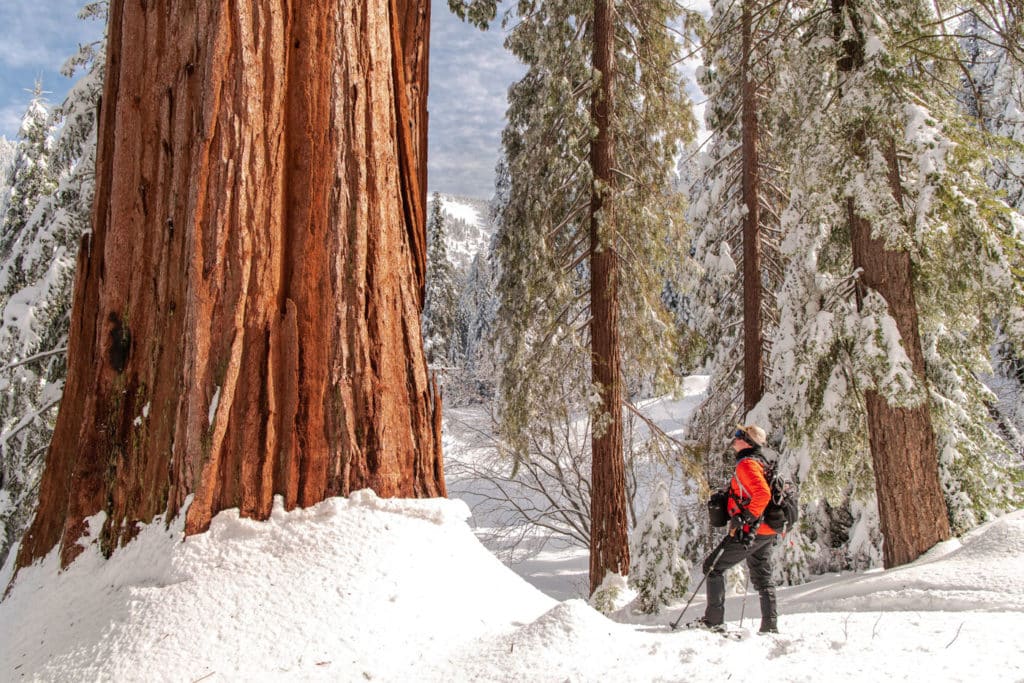What’s the location and size of the property?
Alder Creek is a 530-acre property off California State Route 190 near Camp Nelson in the southern Sierra Nevada. It is surrounded on three sides by the Giant Sequoia National Monument and Sequoia National Forest.
Why was the acquisition of this property a priority for the League?
The League strongly believes that a giant sequoia grove of this significance should be permanently protected and shared with the public.
There are only 25,000 acres of giant sequoia forest in the world, making every inch critically important. The 530-acre property is an exceptional example of ancient, wild California. It contains hundreds of ancient giant sequoias. The forest includes a diversity of age classes, from young sprouts to towering trees that are thousands of years old. Among these are the Stagg Tree, believed to be the fifth biggest known tree on the planet. The property also supports mature forests of red fir, white fir, ponderosa pine, and sugar pine and encompasses a variety of wildland habitats, including meadows and wetlands.
Are any imperiled species found on the property?
While wildlife surveys are still underway, the property includes ideal habitat for several species of concern that live in the area, including Pacific fisher, American marten, and California spotted owl.
Will Save the Redwoods League retain ownership of the property?
No. The League intends to own and manage the property for a period of up to 5-10 years. During this time the League will develop and implement forest restoration and stewardship activities and develop public access plans. Ultimately, the League will transfer ownership of Alder Creek to the USDA Forest Service for inclusion in the Giant Sequoia National Monument. During the League’s ownership, we plan to implement fuels reduction and reforestation activities on the property to reduce the risk of severe fires and help the forest recover from past fire.
Are there any specific management or restoration plans for the property?
The League will work with the USDA Forest Service on management goals, according to the general plan for the Giant Sequoia National Monument. Though most of the property is in great condition, some fuels reduction work and post-fire restoration and reforestation are necessary. Some parts of the property have not had any fire or thinning in over 100 years, resulting in dense stands of trees that can contribute to severe fires. We will conduct forest thinning where it’s needed. The League will also conduct a public access and recreation plan and pursue potential improvements to reopen public visitation to this extraordinary forest.
Did Alder Creek burn in any recent fires?
In September 2020, the Castle Fire, also known as the SQF Complex Fire, reached Alder Creek. While most of the property was unburned or burned at low to moderate severity, roughly 38% burned at high severity.
Were any monarch sequoias burned in the fire?
At least 108 large, old-growth giant sequoias were killed in high-severity areas of the Castle Fire.
How has the property changed since the fire?
In areas that were impacted by low- to moderate-severity fire, the forest and meadows are still healthy, hundreds of ancient sequoias remain standing, and some seedlings have sprouted in low-severity burn areas. However, in some areas, severe fire destroyed the forest canopy and giant sequoia cones and seeds, as well as damaged the soil, meaning these areas cannot recover on their own and reforestation will be needed.
What is Save the Redwoods League doing for post-fire recovery?
In 2021 the League started a multiyear fire recovery project intended to accelerate the return of a healthy forest ecosystem that will be prepared for the next fire. The League and our partners are conducting research on seedling survival, as well as restoration planting. We have an opportunity to model good stewardship of giant sequoia groves while Alder Creek is under our ownership to encourage greater fire resilience across the giant sequoia range in the current era of unprecedented high-severity wildfires.
What is Save the Redwoods League’s reforestation plan?
After preparing several areas of the high-severity burned area of Alder Creek, Save the Redwoods League is planting over 53,000 seedlings of sequoia, sugar pine, ponderosa pine, and white fir in spring 2023. The League will continue to monitor future growth and adjust our reforestation plan accordingly.
Why is Save the Redwoods League removing timber from the Alder Creek property?
Save the Redwoods League is committed to using every tool available to aid in the restoration of Alder Creek. Timber removal is among those tools and is used in areas where fire killed an unnaturally high number of trees, which pose a threat to reforestation efforts. Large stands of dead standing trees can fall over in the years following the fire, restricting new growth of trees and posing a fire hazard that would kill any new seedlings and require the reforestation process to start again. Because some of these trees need to be removed from the property, the League is transporting these logs off site to a mill. The League is using funds generated by the sale of timber only to fund its reforestation efforts and is not netting a profit of the sale.
Why not let the property recover on its own?
Forests that burn at high severity on large scales like parts of Alder Creek are especially susceptible to type-conversion after these types of events. Type-conversion is when the pre-fire forest landscape is replaced by species of plants or shrubs that were not dominant before. In this case, our concern is that previously forested areas will now be dominated by shrubs, which changes habitat availability, restricts the growth of new trees, and promotes repeated high severity wildfire. This is growing increasingly common following severe wildfires with large patches of high severity. To protect the remaining sequoia grove and the neighboring community, Save The Redwoods League is taking management steps to ensure the return of a forest characterized by the tree species that existed before the fire.
